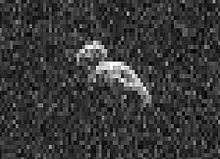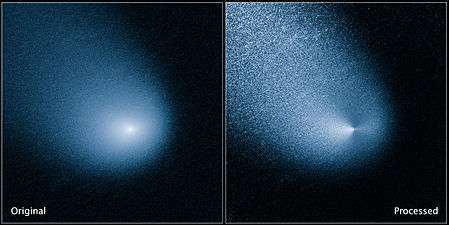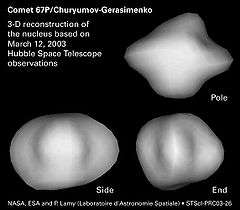Kepler-186f
| Exoplanet | List of exoplanets | |
|---|---|---|
 | ||
| Parent star | ||
| Star | Kepler-186 | |
| Constellation | Cygnus | |
| Right ascension | (α) | 19h 54m 36.651s |
| Declination | (δ) | +43° 57′ 18.06″ |
| Apparent magnitude | (mV) | 14.625 |
| Distance | 558 ly (171[3] pc) | |
| Spectral type | M1V[3] | |
| Mass | (m) | 0.544 (± 0.02)[3] M☉ |
| Radius | (r) | 0.523 (± 0.02)[3] R☉ |
| Temperature | (T) | 3755 (± 90)[3] K |
| Metallicity | [Fe/H] | −0.26 (± 0.12)[3] |
| Age | 4.0 (± 0.6)[3] Gyr | |
| Physical characteristics | ||
| Mass | (m) | 1.4[1][lower-alpha 1] M⊕ |
| Radius | (r) | 1.17 (± 0.08)[3] R⊕ |
| Stellar flux | (F⊙) | 0.32 +0.06 −0.04[1] ⊕ |
| Temperature | (T) | 188 K (−85 °C; −121 °F) |
| Orbital elements | ||
| Semi-major axis | (a) | 0.432 (± 0.01)[3] AU |
| Eccentricity | (e) | 0.04 |
| Orbital period | (P) | 129.9444 (± 0.0012) d (0.355772 y) |
| Inclination | (i) | 89.9° |
| Discovery information | ||
| Discovery date | 17 April 2014 | |
| Discoverer(s) | Elisa Quintana | |
| Discovery method | Transit | |
| Discovery site | Kepler Space Observatory | |
| Discovery status | Published refereed article | |
| Other designations | ||
| KOI-571.05; Kepler-186 f; K00571.05; 2MASS J19543665+4357180 f; KIC 8120608 f; KOI-571 f; WISE J195436.65+435717.9 f | ||
| Database references | ||
| Extrasolar Planets Encyclopaedia | data | |
| SIMBAD | data | |
| Exoplanet Archive | data | |
| Open Exoplanet Catalogue | data | |
Kepler-186f (also known by its Kepler Object of Interest designation KOI-571.05) is an exoplanet orbiting the red dwarf Kepler-186,[4][5][6] about 560 light-years (171 parsecs, or nearly 5.298×1015 km) from the Earth.[1] It is the first planet with a radius similar to Earth's to be discovered in the habitable zone of another star. NASA's Kepler spacecraft detected it using the transit method, along with four additional planets orbiting much closer to the star (all modestly larger than Earth).[5] Analysis of three years of data was required to find its signal.[7] The results were presented initially at a conference on 19 March 2014[8] and some details were reported in the media at the time.[9][10] The public announcement was on 17 April 2014,[2] followed by publication in Science.[1]
Characteristics
Mass, radius and temperature
The only physical property directly derivable from the observations (besides the orbital period) is the ratio of the radius of the planet to that of the central star, which follows from the amount of occultation of stellar light during a transit. This ratio was measured to be 0.021.[1] This yields a planetary radius of 1.11±0.14 times that of Earth,[2][5] taking into account uncertainty in the star's diameter and the degree of occultation. Thus, the planet is about 11% larger in radius than Earth (between 4.5% smaller and 26.5% larger), giving a volume about 1.37 times that of Earth (between 0.87 and 2.03 times as large).
A very wide range of possible masses can be calculated by combining the radius with densities derived from the possible types of matter from which planets can be made. For example, it could be a rocky terrestrial planet or a lower density ocean planet with a thick atmosphere. A massive hydrogen/helium (H/He) atmosphere is thought, however, to be unlikely in a planet with a radius below 1.5 R⊕. Planets with radii of more than 1.5 times that of Earth tend to accumulate the thick atmospheres that would make them less likely to be habitable.[11] Red dwarfs emit a much stronger extreme ultraviolet (XUV) flux when young than later in life. The planet's primordial atmosphere would have been subjected to elevated photoevaporation during that period, which would probably have largely removed any H/He-rich envelope through hydrodynamic mass loss.[1]
Mass estimates range from 0.32 M⊕ for a pure water/ice composition to 3.77 M⊕ if made up entirely of iron (both implausible extremes). For a body with radius 1.11 R⊕, a composition similar to that of Earth (i.e., 1/3 iron, 2/3 silicate rock) yields a mass of 1.44 M⊕,[1] taking into account the higher density due to the higher average pressure compared to Earth.
The estimated equilibrium temperature for Kepler-186f, which is the surface temperature without an atmosphere, is said to be around 188 K (−85 °C; −121 °F), somewhat colder than the equilibrium temperature of Mars.[12]
Host star
The planet orbits a (M-type) star named Kepler-186, orbited by a total of five planets. The star has a mass of 0.54 M☉ and a radius of 0.52 R☉. It has a temperature of 4017 K and is about 4 billion years old,[3] about 600 million years younger than the Sun, which is 4.6 billion years old[13] and has a temperature of 5778 K.[14]
The star's apparent magnitude, or how bright it appears from Earth's perspective, is 14.62. Therefore, it is too dim to be seen with the naked eye.
Orbit
Kepler-186f orbits its star with about 4% of the Sun's luminosity with an orbital period of 129.9 days and an orbital radius of about 0.40[3] times that of Earth's (compared to 0.39 AU for Mercury). The habitable zone for this system is estimated conservatively to extend over distances receiving from 88% to 25% of Earth's illumination (from 0.23 to 0.46 AU).[15] Kepler-186f receives about 32%, placing it within the conservative zone but near the outer edge, similar to the position of Mars in our Solar System.[1]
Habitability
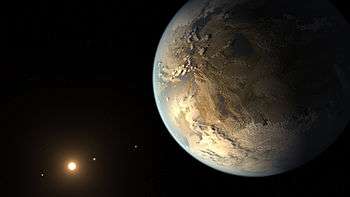
Kepler-186f's location within the habitable zone does not ensure it is habitable; this is also dependent on its atmospheric characteristics, which are unknown.[16] Kepler-186f is too distant, however, for its atmosphere to be analyzed by existing telescopes (e.g., NESSI) or next-generation instruments such as the James Webb Space Telescope.[5][17] A simple climate model, in which the planet's inventory of volatiles is restricted to nitrogen, carbon dioxide and water and clouds are not accounted for, suggests that the planet's surface temperature would be above 273 K (0 °C; 32 °F) if at least 0.5 to 5 bars of CO2 is present in its atmosphere, for assumed N2 partial pressures ranging from 10 bar to zero, respectively.[18]
The star hosts four other planets discovered so far, although Kepler-186 b, c, d, and e (in order of increasing orbital radius), being too close to their star, are considered too hot to have liquid water. The four innermost planets are probably tidally locked, but Kepler-186f is in a higher orbit, where the star's tidal effects are much weaker, so the time could have been insufficient for its spin to slow down significantly. Because of the very slow evolution of red dwarfs, the age of the Kepler-186 system was poorly constrained, although it is likely to be greater than a few billion years.[18] Recent results have placed the age at around 4 billion years.[3] The chance that it is tidally locked is approximately 50%. Since it is closer to its star than Earth is to the Sun, it will probably rotate much more slowly than Earth; its day could be weeks or months long (see Tidal effects on rotation rate, axial tilt and orbit).[19]
Kepler-186f's axial tilt (obliquity) is likely very small, in which case it would not have tilt-induced seasons as Earth and Mars do. Its orbit is probably close to circular,[19] so it will also lack eccentricity-induced seasonal changes like those of Mars. However, the axial tilt could be larger (about 23 degrees) if another undetected nontransiting planet orbits between it and Kepler-186e; planetary formation simulations have shown that the presence of at least one additional planet in this region is likely. If such a planet exists, it cannot be much more massive than Earth as it would then cause orbital instabilities.[18]
One review assay in 2015 concluded that Kepler-186f, along with the exoplanets Kepler-442b and Kepler-62f, were likely the best candidates for being potentially habitable planets.[20]
Follow-up studies
Target of SETI investigation
As part of the SETI Institute's search for extraterrestrial intelligence, the Allen Telescope Array had listened for radio emissions from the Kepler-186 system for about a month as of 17 April 2014. No signals attributable to extraterrestrial technology were found in that interval, however to be detectable such transmissions, if radiated in all directions equally and thus not preferentially towards the Earth, would need to be at least 10 times as strong as those from Arecibo Observatory.[7] Another search, undertaken at the crowdsourcing project SETILive, reports inconclusive but optimistic-looking signs in the radio noise from the Allen Array observations.[21] The more well known Seti@Home search does not cover any object in the Kepler field of view.[22] Another follow-up survey using the Green Bank Telescope has not reviewed Kepler 186f.[23] Given the interstellar distance of 490 light-years (151 pc), the signals would have left the planet that many years ago.
Future technology
At nearly 560 light-years (171 pc) distant, Kepler-186f is too far and its star too faint for current telescopes or the next generation of planned telescopes to determine its mass or whether it has an atmosphere. However, the discovery of Kepler-186f demonstrates conclusively that there are other Earth-sized planets in habitable zones. The Kepler spacecraft focused on a single small region of the sky but next-generation planet-hunting space telescopes, such as TESS and CHEOPS, will examine nearby stars throughout the sky. Nearby stars with planets can then be studied by the upcoming James Webb Space Telescope and future large ground-based telescopes to analyze atmospheres, determine masses and infer compositions.[19] Additionally the Square Kilometer Array would significantly improve radio observations over the Arecibo Observatory and Green Bank Telescope.[23]
Previous names
As the Kepler telescope observational campaign proceeded, an initially identified system was entered in the Kepler Input Catalog (KIC), and then progressed as a candidate host of planets to a Kepler Object of Interest (KOI). Thus, Kepler 186 started as KIC 8120608 and then was identified as KOI 571.[24] Kepler 186f was mentioned when known as KOI-571-05 or KOI-571.05 or using similar nomenclatures in 2013 in various discussions and publications before its full confirmation.[25]
Comparison
The nearest-to-Earth-size planet in a habitable zone previously known was Kepler-62f with 1.4 Earth radii. Kepler-186f orbits an M-dwarf star, while Kepler-62f orbits a K-type star. A study of atmospheric evolution in Earth-size planets in habitable zones of G-Stars (a class containing the Sun, but not Kepler-186) suggested that 0.8–1.15 R⊕ is the size range for planets small enough to lose their initial accreted hydrogen envelope but large enough to retain an outgassed secondary atmosphere such as Earth's.[26]
| Notable Exoplanets – Kepler Space Telescope |
|---|
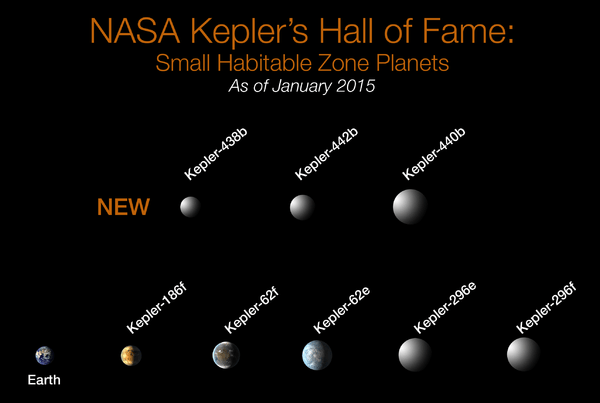
(Kepler-62e, Kepler-62f, Kepler-186f, Kepler-296e, Kepler-296f, Kepler-438b, Kepler-440b, Kepler-442b) (Kepler Space Telescope; 6 January 2015).[27] |
In popular culture
- Along with five other exoplanets, Kepler-186f was included in Civilization: Beyond Earth's exoplanet DLC as a playable map.[28]
See also
Notes
References
- 1 2 3 4 5 6 7 8 9 10 Quintana, E. V.; et al. (2014-04-18). "An Earth-Sized Planet in the Habitable Zone of a Cool Star" (PDF). Science. 344 (6181): 277–280. arXiv:1404.5667
 . Bibcode:2014Sci...344..277Q. doi:10.1126/science.1249403.
. Bibcode:2014Sci...344..277Q. doi:10.1126/science.1249403. - 1 2 3 Johnson, Michele; Harrington, J.D. (17 April 2014). "NASA's Kepler Discovers First Earth-Size Planet In The 'Habitable Zone' of Another Star". NASA. Archived from the original on 2014-04-17.
- 1 2 3 4 5 6 7 8 9 10 11 12 "Kepler-186 f". NASA Exoplanet Archive. Retrieved 19 July 2016.
- ↑ Chang, Kenneth (17 April 2014). "Scientists Find an 'Earth Twin', or Maybe a Cousin". New York Times.
- 1 2 3 4 Chang, Alicia (17 April 2014). "Astronomers spot most Earth-like planet yet". Associated Press. Archived from the original on 2014-04-18.
- ↑ Morelle, Rebecca (17 April 2014). "'Most Earth-like planet yet' spotted by Kepler". BBC News. Archived from the original on 2014-04-18.
- 1 2 Quintana, Elisa (17 April 2014). "Kepler 186f – First Earth-sized Planet Orbiting in Habitable Zone of Another Star". SETI Institute. Archived from the original on 2014-04-18.
- ↑ Staff (16 March 2014). "EBI – Search for Life Beyond the Solar System 2014 – Exoplanets, Biosignatures & Instruments". EBI2014. Archived from the original on 2014-04-18. See session 19 March 2014 – Wednesday 11:50–12:10 – Thomas Barclay: The first Earth-sized habitable zone exoplanets.
- ↑ Klotz, Irene (20 March 2014). "Scientists Home In On Earth-Sized Exoplanet". Discovery Communications. Archived from the original on 2014-04-18.
- ↑ Woollaston, Victoria (24 March 2014). "Has NASA found a new Earth? Astronomer discovers first same-sized planet in a 'Goldilocks zone' that could host alien life". Daily Mail. Archived from the original on 2014-03-25.
- ↑ "NASA Kepler telescope discovers planet believed to be most Earth-like yet found". The Guardian. London. Press Association. 17 April 2014. Archived from the original on 2014-04-18.
- ↑ http://phl.upr.edu/projects/habitable-exoplanets-catalog
- ↑ Fraser Cain (16 September 2008). "How Old is the Sun?". Universe Today. Retrieved 19 February 2011.
- ↑ Fraser Cain (15 September 2008). "Temperature of the Sun". Universe Today. Retrieved 19 February 2011.
- ↑ http://www.hpcf.upr.edu/~abel/phl/hec_plots/hec_orbit/hec_orbit_Kepler-186_f.png
- ↑ Clark, Stephen (17 April 2014). "Earth's 'cousin' planet lies 500 light-years away". Spaceflight Now. Archived from the original on 2014-04-18.
- ↑ Greenfieldboyce, Nell (17 April 2014). "Scientists Spot A Planet That Looks Like 'Earth's Cousin'". National Public Radio. Archived from the original on 2014-04-18.
- 1 2 3 Bolmont, Emeline; Raymond, Sean N.; von Paris, Philip; Selsis, Franck; Hersant, Franck; Quintana, Elisa V.; Barclay, Thomas (27 August 2014). "Formation, tidal evolution and habitability of the Kepler-186 system". The Astrophysical Journal. 793 (1): 3. arXiv:1404.4368
 . Bibcode:2014ApJ...793....3B. doi:10.1088/0004-637X/793/1/3.
. Bibcode:2014ApJ...793....3B. doi:10.1088/0004-637X/793/1/3. - 1 2 3 Staff (17 April 2014). "Kepler 186f – A Planet in the Habitable Zone (video)". Hangout On-Air. SETI Institute. Archived from the original on 2014-04-18. Retrieved 2014-04-18.
- ↑ Paul Gilster, Andrew LePage (2015-01-30). "A Review of the Best Habitable Planet Candidates". Centauri Dreams, Tau Zero Foundation. Retrieved 2015-07-24.
- ↑ Farmer, Hontas (18 April 2014). "A better than 50/50 chance Kepler-186f has technological life". Science 20. Archived from the original on 2014-04-28.
- ↑ See the fourth question at Kevvy, Mr. (20 Mar 2014). "The (Preliminary and Premature) Green Bank SERENDIP Fundraiser - Help SETI@Home Build a New (non-Arecibo) Receiver!". SETI@home. Archived from the original on 2014-05-04.
- 1 2 Siemion, Andrew P.V.; Demorest, Paul; Korpela, Eric; Maddalena, Ron J.; Werthimer, Dan; Cobb, Jeff; Langston, Glen; Lebofsky, Matt; Marcy, Geoffrey W.; Tarter, Jill (2013). "A 1.1 to 1.9 GHz SETI Survey of the Kepler Field: I. A Search for Narrow-band Emission from Select Targets". The Astrophysical Journal. 767 (1): 94. arXiv:1302.0845
 . Bibcode:2013ApJ...767...94S. doi:10.1088/0004-637X/767/1/94.
. Bibcode:2013ApJ...767...94S. doi:10.1088/0004-637X/767/1/94. - ↑ Rowe, Jason F.; et al. (27 February 2014). "Validation of Kepler's Multiple Planet Candidates. III: Light Curve Analysis & Announcement of Hundreds of New Multi-planet Systems". The Astrophysical Journal. 784: 45. arXiv:1402.6534
 . Bibcode:2014ApJ...784...45R. doi:10.1088/0004-637X/784/1/45.
. Bibcode:2014ApJ...784...45R. doi:10.1088/0004-637X/784/1/45. - ↑ Glister, Paul (5 November 2013). "Earth-Sized Planets in Habitable Zone Common". Centauri Dreams. Archived from the original on 2014-04-19. See comment by "Holger 16 November 2013 at 14:21".
^ redakce ["editor"] (6 August 2013). "Kepler (asi) našel obyvatelnou planetu o velikosti Země" [Kepler (probably) found a habitable planet the size of Earth] (in Czech). exoplanety.cz. Archived from the original on 2013-08-20.
^ "Kepler: Erster Kandidat einer habitablen Exoerde Veröffentlicht" [Kepler: First candidate of a habitable Exoplanet Published]. Zauber der Sterne [Magic of the stars] (in German). 19 August 2013. Archived from the original on 2013-09-27.
^ Bovaird, Timothy; Lineweaver, Charles H. (1 August 2013). "Exoplanet Predictions Based on the Generalised Titius-Bode Relation". Monthly Notices of the Royal Astronomical Society. 435 (2): 14–15. arXiv:1304.3341 . Bibcode:2013MNRAS.435.1126B. doi:10.1093/mnras/stt1357.
. Bibcode:2013MNRAS.435.1126B. doi:10.1093/mnras/stt1357. - ↑ Lammer, H.; Stökl, A.; Erkaev, N.V.; Dorfi, E.A.; Odert, P.; Güdel, M.; Kulikov, Yu.N.; Kislyakova, K.G.; Leitzinger, M. (13 January 2014). "Origin and Loss of nebula-captured hydrogen envelopes from "sub"- to "super-Earths" in the habitable zone of Sun-like stars". Monthly Notices of the Royal Astronomical Society. 439 (4): 3225. arXiv:1401.2765
 . Bibcode:2014MNRAS.439.3225L. doi:10.1093/mnras/stu085.
. Bibcode:2014MNRAS.439.3225L. doi:10.1093/mnras/stu085. - ↑ Clavin, Whitney; Chou, Felicia; Johnson, Michele (6 January 2015). "NASA's Kepler Marks 1,000th Exoplanet Discovery, Uncovers More Small Worlds in Habitable Zones". NASA. Retrieved 6 January 2015.
- ↑ "Civilization: Beyond Earth". Steam.
External links
| Wikimedia Commons has media related to Kepler-186 f. |
- NASA – Kepler Mission.
- NASA – Kepler Discoveries – Summary Table.
- NASA – Kepler-186f at The NASA Exoplanet Archive.
- NASA – Kepler-186f at The Exoplanet Data Explorer.
- NASA – Kepler-186f at The Extrasolar Planets Encyclopaedia.
- Habitable Exolanets Catalog at UPR-Arecibo.
- NASA – Kepler 186f – SETI Institute – A Planet in the Habitable Zone (video) 2014.
- NASA – NASA Press kit.
Coordinates: ![]() 19h 54m 36.651s, +43° 57′ 18.06″
19h 54m 36.651s, +43° 57′ 18.06″

